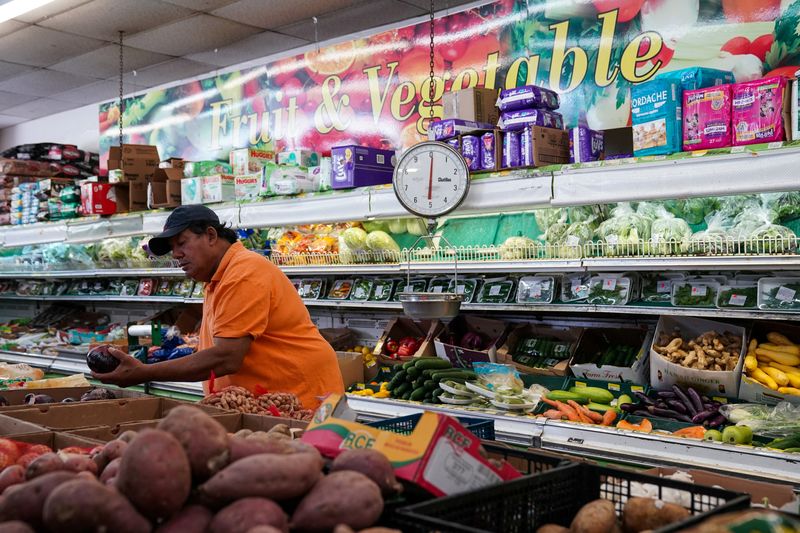By Lucia Mutikani
WASHINGTON (Reuters) -U.S. producer prices rose less than expected in December as higher costs for goods were partially offset by stable services prices, suggesting inflation remained on a downward trend after progress had stalled in recent months.
The moderation in producer inflation reported by the Labor Department on Tuesday did not change the view that the Federal Reserve would not cut interest rates again before the second half of this year amid labor market resilience and the threat of potentially inflation-boosting tariffs on imported goods by President-elect Donald Trump's incoming administration.
"Better than expected is not necessarily what the Fed wants to see before easing monetary conditions into a fast-growing economy, with tariffs and tax cuts on the agenda of the incoming administration," said Carl Weinberg, chief U.S. economist at High Frequency Economics.
The producer price index for final demand rose 0.2% last month after an unrevised 0.4% advance in November, the Labor Department's Bureau of Labor Statistics said. Economists polled by Reuters had forecast the PPI would climb 0.3%.
In the 12 months through December, the PPI accelerated 3.3%, the most since February 2023, after increasing 3.0% in November.
The surge in the year-on-year rate reflected lower prices last year, especially for energy products, that dropped out of the calculation. Inflation increased 3.3% in 2024 after rising 1.1% in 2023.
The narrower measure of PPI, which strips out food, energy and trade, ticked up 0.1% for a second straight month. Core PPI increased 3.3% on a year-on-year basis after advancing 3.5% in November. Some economists cautioned against reading too much into the benign rise in the monthly PPI, arguing that producer prices tended to be softer in December.
They did not expect the tame reading to extend to the consumer price data for December due to be released on Wednesday. A Reuters survey forecast consumer prices would rise 0.3%, matching November's gain.
"Today's PPI numbers should offer absolutely no comfort about tomorrow's CPI release," said Stephen Stanley, chief U.S. economist at Santander (BME:SAN) US Capital Markets.
Lack of progress lowering inflation back to the U.S. central bank's 2% target, a resilient economy and uncertainty over the impact of the Trump administration's policies, including tax cuts and mass deportations of undocumented immigrants, prompted the Fed to project a shallower rate-cut path this year.
The government last week reported a sharp rise in nonfarm payrolls in December and a decline in the unemployment rate, which led economists to expect that the U.S. central bank would keep rates unchanged through June.
Bank of America Securities now believes the Fed's easing cycle is over. Goldman Sachs expects two rate cuts this year, in June and December, a number revised down from three.
The central bank kicked off its easing cycle in September and has lowered its benchmark overnight interest rate by 100 basis points to the current 4.50%-4.75% range.
The last reduction occurred in December when policymakers also projected two rate cuts this year instead of the four they had forecast in September.
WHOLESALE FOOD PRICES FALL
Stocks on Wall Street were trading mostly lower. U.S. Treasury yields slipped and the dollar eased against a basket of currencies.
Wholesale goods prices increased 0.6% in December after shooting up 0.7% in the prior month. They were driven by a 3.5% jump in the prices of energy products, with gasoline rising 9.7%. Food prices, however, dipped 0.1% after accelerating 2.9% in November. Wholesale egg prices rose 0.5% after surging 55.6% in November amid an avian flu outbreak.
Excluding the volatile food and energy components, goods prices were unchanged for the first time since March. That followed a 0.2% gain in the so-called core goods in November.
Services prices were flat following a 0.3% increase in November. Transportation and warehousing services prices rose 2.2%, with the cost of airline fares soaring 7.2%. Portfolio management fees rebounded 0.2%, but the cost of hotels and motel rooms decreased 6.9% after declining 1.2% in November.
Healthcare costs were mostly benign, with prices for physician care rising 0.2%. The cost of hospital inpatient care was unchanged while that of dental care edged up 0.1%.
Portfolio management fees, healthcare, hotel and motel accommodation and airline fares are among the components that go into the calculation of the Personal Consumption Expenditures (PCE) Price Index, excluding food and energy.
Based on the PPI data, economists estimated the PCE price index, excluding food and energy, rose 0.2% in December. The so-called core PCE inflation nudged up 0.1% in November. In the 12 months through December, core inflation was forecast to advance 2.9% after rising 2.8% for two straight months.

Those estimates could change after the release of the consumer price data. The core PCE inflation is one of the measures tracked by the Fed for monetary policy.
"The risks are for less cuts ... but we expect continued progress on the inflation front could keep the Fed on track to deliver a rate cut at the March meeting," said Matthew Martin, a senior U.S. economist at Oxford Economics.